Bayesian Predictive Model for Electric Level 4 Connected Automated Vehicle Adoption
Abstract
1. Introduction
- Level 1: Driver Assistance
- Level 2: Partial Driving Automation
- Level 3: Conditional Driving Automation
- Level 4: High Driving Automation
- Level 5: Full Driving Automation
- (1)
- Predicting the effectiveness of electric Level 4 CAVs under uncertain states of technology and infrastructure readiness in three applications, namely (a) private mobility, (b) robotaxi shared mobility, and (c) shared mobility microtransit services.
- (2)
- Addressing uncertainties in effectiveness estimates using the Monte Carlo method and producing two probability-weighted expected effectiveness estimates for each CAV application, one corresponding to a relatively low level of technology and infrastructure readiness, and another corresponding to a higher level of readiness. These are needed as inputs to the Bayesian predictive model.
- (3)
- Formulation and implementation of the Bayesian model for predicting the probability of CAV adoption in 2030–2035 application scenarios of technology and infrastructure readiness states, including the quantification of the value of new information obtainable from demonstration studies intended to reduce uncertainties in the readiness states.
- (4)
- Obtaining insights from the predictive model results on the conditions under which CAVs are likely to be adopted in the 2030–2035 period.
2. Methodological Framework
- Several interest groups are keen on learning about CAV adoption forecasts. These include vehicle manufacturers and marketers, public sector infrastructure owners and operators, private sector transportation companies, financial institutions and investors, consulting firms, researchers, and consumer groups.
- Factors that could be used to forecast decisions on CAV adoption for various applications include technological capabilities, infrastructure for supporting CAV use, government regulations, differences between CAV and non-CAV travel characteristics, trends in general consumer acceptance of automation in driving, technology costs, and investor sentiments.
- With no substantive CAV market in place today, a methodological framework for forecasting must rely entirely on informed subjective estimates of CAV application effectiveness.
- Treating uncertainty in all of the inputs to a predictive model is necessary. Likewise, all parts of the Bayesian model support decision-making under uncertainty.
- Working with effectiveness criteria that can be quantified largely in non-monetary terms (e.g., user satisfaction, technology malfunction).
- Due to uncertainties in technology and infrastructure readiness and user acceptance of CAVs (i.e., for personal mobility, as a shared mobility vehicle), the method should be able to work with a range of criteria achievement levels.
- Use of a widely utilized method to account for uncertainties in criteria achievement levels and to produce probability-weighted expected effectiveness outputs required as inputs to the Bayesian predictive model.
- Need for a predictive model with the following necessary capabilities:
- (a)
- Applying probabilities to uncertain states of technology and infrastructure readiness.
- (b)
- Enabling a role for new information on uncertain variables, obtainable from demonstrations.
- (c)
- Updating probabilities of uncertain states of technology and infrastructure readiness using the new information.
- (d)
- Producing answers as to the value of new information in reducing uncertainties and enhancing the basis for CAV deployment decision for services defined above.
3. Overview of Level 4 CAV Technology and Infrastructure
4. 2030–2035 Service Context
4.1. Private Mobility Vehicle
4.2. Robotaxi
4.3. Microtransit Service
5. Level 4 CAV Technology and Infrastructure Attributes
5.1. Positive Attributes (2030–2035 Service Context)
- Human factor-related collisions avoided (safety benefit).
- User satisfaction (as owner of the personal passenger vehicle, user of the robotaxi service, or user of the CAV-based microtransit service).
- Socio-economic benefits (other than safety benefits).
- Environmental benefits.
5.2. Negative Attributes (2030–2035 Service Context)
- Technology unreliability.
- Effect on other road users.
- Hacking and data security.
- Cost differential (i.e., extra cost of automation).
6. Uncertain States and Decision-Making Under Uncertainty
7. Quantifying the Effectiveness of CAV Application in Meeting Owner/User Criteria
7.1. Utility (Relative Value) Theory
- e is the effectiveness of the Level 4 CAV application.
- Cri is the achievement level, by the CAV, of a criterion i, i = 1,2, …, q.
- e(Cri) is the utility of achieving Cri (e.g., collisions avoided).
- pi(Cri) is the probability that Cri will be achieved by the CAV application (e.g., robotaxi).
- The effectiveness values are estimated as ranges, the higher the degree of uncertainty, the wider are the estimates.
- The Monte Carlo method, described in the following section, is applied to calculate the probability-weighted expected value of criterion achievement.
- Next, the expected value of criterion achievement level obtained from Monte Carlo simulation can be transformed, if warranted.
- e(Cri) = the utility measure, in transformed units, for criterion Cri.
- H and z are constants.
- For the case of linear transformation with an intercept,
- mi = the slope of the transformation curve for Cri
- bi = the vertical axis intercept (if applicable, a threshold step can be applied).
- ej = the expected effectiveness of CAV application j, weighted for all impact/interest groups
- wi = the weight assigned to criterion i
7.2. Montecarlo Method to Treat Uncertainties
7.3. Computation of Criteria-Weighted Effectiveness
7.3.1. Effectiveness Criteria Weights
7.3.2. Private Vehicle Effectiveness
- Cr1 Human factor-related collisions avoided: The values range from 25 to 70 utils. Survey results clearly suggest that potential adopters as well as technology experts are calling for increased safety in vehicle design and improved road infrastructure. Also, the need for “more regulations” is noted [46,61]. According to the Victoria Transport Policy Institute, “many technical problems must be solved before autonomous vehicles can operate reliably in all normal conditions” [12]. The low end of 25 utils collision avoidance effectiveness is plausible for Level 4 CAVs under the S1 scenario that reflects operation of an under-developed vehicle without the required infrastructure support. On the other hand, the high effectiveness level is achievable under S2, which characterizes a state free of technical problems [46,61].
- Cr2 User satisfaction: The range is from 30 to 45 utils under both S1 and S2. A CAV that may be allowed to operate in the 2030–2035 service environment is likely to have a moderate level of capability that users require (e.g., automated longitudinal and lateral movements, parking assistance) [46,61].
- Cr3 Socio-economic benefits: The overall range of 15 to 40 utils reflects a general lack of experience in obtaining socio-economic benefits from the new technology. Some authors include driving-related savings in this category of CAV effectiveness. In relative terms, the CAV under S2 has higher potential to generate benefits than under S1 due to favorable technology and infrastructure developments [12,45,61].
- Cr4 Environment-related effects: The range of 20 to 40 utils is based on survey information that showed that about 12% of EV owners are well set in terms of chargers and another about 28% are getting close to having enough chargers needed [61]. Under S2, the environment-related benefit is higher than S1 due to higher level of infrastructure readiness.
- Cr5 Technology unreliability: Potential adopters and experts have concerns regarding technical issues. About 56 percent of survey respondents were concerned about technology malfunction [61]. The ranges defined (i.e., −25 to −50 utils under S1 and 0 to −25 under S2) reflect opinions expressed by numerous authors, survey information, and the belief that CAV technology is likely to improve over time [9,10,11,12,13,14,15,16,17,18,19,20,21,22,23,24,25,61].
- Cr6 Effect on road users: Although there are no survey data on the percentage of experts concerned about the impact of Level 4 CAVs on other road users, research indicates that their safety is a valid concern. [12]. The effectiveness range under S1 is from −35 to −65 utils, but it improves to 0 to −30 utils under S2.
- Cr7 Hacking and data security: 46% of survey respondents are concerned about vehicle hacking and 55% show data privacy as an issue with Level 4 CAV technology and operations [46]. These statistics are reflected in the −25 to −50 utils range under S1. However, technology and operational improvements provide sufficient basis for the 0 to −20 utils range under S2 [12,46].
- Cr8 Cost differential: 68% of respondents are extremely or very concerned about the purchase price of Level 4 CAVs [46]. Additionally, there are concerns with maintenance costs [9,10,11,12,13,14,15,16,17,18,19,20,21,22,23,24,25]. The effectiveness range of −60–90 utils under S1 reflects much concern. However, due to dropping costs, the range improves to −10 to −40 utils under S2.
7.3.3. Ride-Hailing Robotaxi Effectiveness
7.3.4. Microtransit Vehicle Effectiveness
8. Bayesian Model: Theory
8.1. Prior Analysis
- Alternatives: A1 adopt CAV; A2 do not adopt CAV.
- The condition under which the adoption decision will be made is characterized by the following uncertain states of technology and infrastructure readiness: S1 low state of technology and infrastructure readiness; S2 higher state of readiness.
- The impact (consequence) of each A&S combination is quantified by the expected weighted effectiveness values presented Table 3, Table 4, Table 5, Table 6, Table 7 and Table 8. In Bayesian analyses, these are termed as Gain G of CAV adoption. Depending upon the specific A&S combination, the G can be negative or positive.
- The uncertain states are assigned probabilities of occurrence. These probabilities are called prior probabilities. The term prior is used because the decision maker has the option to ask for a demonstration study, and the new information can be used for revising prior probabilities into posterior probabilities.
8.2. Posterior Analysis
- Using the prior analysis as a base, the prior probability P′(S) for each S is required before observing the outcome r of the new information acquisition activity L.
- A conditional measure P(r|S,L) is to be assigned, which represents the probability that the result r will be observed if the learning activity L is carried out, and S is the true state. That is, the analyst should define the reliability of the information outcome r of L in predicting the true state S.
- The marginal measure P(r|e) is computed as shown next:
- The posterior probability P″(S|r,L) can now be calculated using the Bayes Theorem:
- This equation reflects the Bayesian philosophy that an L can be characterized by a conditional probability P(r|S,L) (a reliability indicator), used for computing posterior probabilities. The Bayes Theorem (Equation (15)) defines the relationship between the prior and posterior probabilities.
8.3. Pre-Posterior Analysis
8.4. Value of New Information
- (1)
- From the posterior branch, for L and each r, find MaxAG*(A,r,L). Call it Ar.
- (2)
- For L0 in the prior branch, find MaxG*(A). Call it A′.
- (3)
- For each r, find (Ar-A′)
- (4)
- The expected value of new information is computed as follows:
9. Application of the Bayesian Model
9.1. Private Automobile
9.2. Robotaxi
9.3. Microtransit
9.4. Effect of Posterior Probabilities on Expected Gain of CAV Adoption
9.5. Role of New Information Obtained from Learning Activity
9.6. Effect of Reliability of New Information
- Technology developers, infrastructure providers, and regulators are on track for improving the safety and reliability of technology and services. Also, detailed information is available on Level 4 CAV technology capabilities and limitations.
- Plans are underway to improve cybersecurity and safeguarding data.
- The potential owner of the Level 4 CAV for private mobility can personally test its automation functions, including the call for human intervention, if needed.
- The potential users of shared mobility Level 4 CAVs intended for robotaxi and microtransit services are offered the opportunity to verify that the remote-control staff can indeed resolve issues.
- By 2030–2035, the automation costs will improve in favor of Level 4 CAV ownership, maintenance, and operations.
- Detailed information is available regarding legal responsibilities in case of an accident.
10. Discussions
11. Conclusions
Funding
Data Availability Statement
Conflicts of Interest
References
- SAE International. Taxonomy and Definitions for Terms Related to Driving Automation Systems for On-Road Motor Vehicles. J3016™. Published in USA and Switzerland. 2021. Available online: https://www.en-standard.eu/pd-iso-sae-pas-22736-2021-taxonomy-and-definitions-for-terms-related-to-driving-automation-systems-for-on-road-motor-vehicles/?gad_source=1&gad_campaignid=22489671069&gclid=EAIaIQobChMI6tvCqNqYjwMVaWNHAR3zywv4EAAYAiAAEgKEJ_D_BwE (accessed on 8 June 2025).
- Nelson, P. The Six Levels of Autonomous Driving, Explained; J.D. Power: Troy, MI, USA, 2025. [Google Scholar]
- Electric Autonomy Canada. B.C. Bans Level 3 and Above Road Autonomy. Electric Autonomy, 18 April 2024. Available online: https://electricautonomy.ca (accessed on 8 June 2025).
- McKinsey & Company. What Is Self-Driving? 5 March 2025. Available online: https://www.mckinsey.com/featured-insights/mckinsey-explainers/what-is-a-self-driving-car (accessed on 8 June 2025).
- Hope, G. Self-Driving Taxi Set for Mass Production Unveiled. IOT World Today. 22 April 2025. Available online: https://www.iotworldtoday.com/transportation-logistics/self-driving-taxi-set-for-mass-production-unveiled (accessed on 8 June 2025).
- US Department of Transportation. Automated Vehicles: Low Speed Shuttles; ITS Deployment Evaluation: Washington, DC, USA. (nd). Available online: https://www.itskrs.its.dot.gov/sites/default/files/2021-09/executive-briefing/EB06-LOW%20SPEED%20AUTOMATED%20SHUTTLES_%2005_16_19_FINAL.pdf (accessed on 8 June 2025).
- Lavauzelle, C.; Jacobsoone, P. Autonomous Vehicles for Public Transportation: The Growing Interest of Local Authorities and Mobility Operators in Renault Group’s Approach. Press Release. Renault Group. Available online: https://media.renaultgroup.com/autonomous-vehicles-for-public-transportation-the-growing-interest-of-local-authorities-and-mobility-operators-in-renault-groups-approach/ (accessed on 8 June 2025).
- James, A. Tech Insider: Street CAV.Cool Britannia. ADAS Auton. Veh. Int. 2025, 4–6. [Google Scholar]
- National Academies of Sciences, Engineering and Medicine. Realistic Timing Estimates for Automated Vehicle Implementation; The National Academies Press: Washington, DC, USA, 2023. [Google Scholar] [CrossRef]
- Society of Actuaries (Mudge & Kornhauser). Automated Vehicle Systems Outlook 2021 Update; Society of Actuaries: Schaumburg, IL, USA, 2021. [Google Scholar]
- Wolfe Research. Autonomous Vehicles: Science Fiction About to Become Reality; Wolfe Research: New York, NY, USA, 2021. [Google Scholar]
- Victoria Transport Policy Institute (Todd Litman). Autonomous Vehicle Implementation Predictions: Implications for Transport Planning; Victoria Transport Policy Institute (Todd Litman): Victoria, BC, Canada, 22 May 2025. [Google Scholar]
- Lavasani, M. Potential Implications of Automated Vehicle Technologies on Travel Behavior and System Modelling. Ph.D. Thesis, Florida International University, Miami, FL, USA, May 2017. [Google Scholar]
- McKinsey Center for Future Mobility. Autonomous Driving’s Future: Convenient and Connected; McKinsey & Company: New York, NY, USA, 2023. [Google Scholar]
- McKinsey & Company. Automotive Revolution—Perspectives Towards 2030; McKinsey & Company: New York, NY, USA, 2016. [Google Scholar]
- McKinsey & Company. Private Autonomous Vehicles: The Other Side of the Robo-Taxi Story; McKinsey & Company: New York, NY, USA, 2020. [Google Scholar]
- Boston Consulting Group (BCG). The Reimagined Car—Shared, Autonomous, and Electric; BCG: Boston, MA, USA, 2017. [Google Scholar]
- CITI GPS Car of the Future v4.0. January 2020. Available online: https://www.citigroup.com/global/insights/car-future-v4-0-2020-update (accessed on 8 June 2025).
- Future Agenda, Open Foresight (Jones and Bishop). The Future of Autonomous Vehicles. 2020. Available online: https://www.connectedautomateddriving.eu/wp-content/uploads/2023/06/Future-Agenda-open-foresight-The-future-of-autonomous-vehicles-Global-Insights-gained-from-Multiple-Expert-Discussions_01-04-2020_Future-Agenda-Limited.pdf (accessed on 8 June 2025).
- S; P Global Ratings. The Road Ahead for Autonomous Vehicles; S&P Global Ratings: New York, NY, USA, 2018. [Google Scholar]
- Frost; Sullivan. Global Autonomous Driving Market Outlook, 2018; Frost & Sullivan: San Antonio, TX, USA, 2018. [Google Scholar]
- ARK Invest (Tasha Keeney). Mobility-As-A-Service: Why Self-Driving Cars Could Change Everything; ARK Invest: St. Petersburg, FL, USA, 2017. [Google Scholar]
- ReThinkX Rethinking Transportation 2020–2030: The Disruption of Transportation and the Collapse of the Internal-Combustion Vehicle and Oil Industries. May 2017. Available online: https://www.amazon.sg/Rethinking-Transportation-2020-2030-Disruption-Internal-Combustion/dp/0999401602 (accessed on 8 June 2025).
- Strategy Analytics (Roger Lanctot). Accelerating the Future. The Economic Impact of the Emerging Passenger Economy. June 2017. Available online: https://www.intel.com/content/dam/www/public/us/en/documents/pdf/passenger-economy-report-autonomous-driving.pdf (accessed on 8 June 2025).
- Morgan Stanley. Autonomous Cars: Self-Driving the New Auto Industry Paradigm. November 2013. Available online: https://www.scirp.org/reference/referencespapers?referenceid=3329197 (accessed on 8 June 2025).
- Toth, C.; Perry, F.; Keshmiri, A. Connected and Autonomous Vehicle Readiness Action Plan; Tennessee Department of Transportation Report #RES2023-29; ROSAP; WSP: Montreal, QC, Canada, 2025. [Google Scholar]
- Transport Canada. Canada’s Safety Framework for Connected and Automated Vehicles 2.0. Ottawa; (TP15562E); Transport Canada: Ottawa, ON, Canada, 2024. [Google Scholar]
- US Department of Transportation (DOT). Preparing for the Future of Transportation: Automated Vehicles; US Department of Transportation (DOT): Washington, DC, USA. (nd). Available online: https://www.transportation.gov/av (accessed on 10 October 2018).
- National Academies of Sciences, Engineering, and Medicine. Connected and Autonomous Vehicle Technology: Determining the Impact on State DOT Maintenance Programs; The National Academies Press: Washington, DC, USA, 2024. [Google Scholar] [CrossRef]
- Feng, J.; Khan, A.M. Accelerating urban road transportation electrification: Planning, technology, economic and implementation factors in converting gas stations into fast charging stations. Energy Syst. J. 2023, 1–32. [Google Scholar] [CrossRef]
- Khan, A.M. Economic Factors. In Shared Mobility and Automated Vehicles, Responding to Socio-Technical Changes and Pandemics; Chapter 16; Khan, A.M., Shaheen, S.A., Eds.; Institution of Engineering and Technology (IET): London, UK, 2022. [Google Scholar]
- McKinsey & Company. Getting on board with shared autonomous mobility. In Automotive and Assembly Practice; McKinsey & Company: Boston, MA, USA; Frankfurt, Germany; Munich, Germany; Houston, TX, USA; Dallas, TX, USA; Zurich, Switzerland, 2025. [Google Scholar]
- Khan, A.M. Planning and Economic Feasibility of Electric-Connected Automated Microtransit First/Last Mile Service Under Uncertainty. Future Transp. 2025, 5, 19. [Google Scholar] [CrossRef]
- Shaheen, S.A.; Cohn, A.P. Navigating seismic shifts in transportation. In Shared Mobility and Automated Vehicles: Responding to Social-Technical Changes and Pandemics; Chapter 2; Khan, A.M., Shaheen, S.A., Eds.; The Institution of Engineering and Technology: London, UK, 2022. [Google Scholar]
- Khan, A.M.; Ren, T. The New Mobility Era: Leveraging Digital Technologies for More Equitable, Efficient and Effective Public Transportation; IRPP Insight: Montreal, QC, Canada, 2024. [Google Scholar]
- Descant, S. Automated Connected Electric Shared (ACES) (USA). Interest in Introducing and Advancing AV Technology; Government Technology: Singapore, 2023. [Google Scholar]
- Federal Ministry of Transport (Germany). Hanseatic City of Hamburg. By 2030, There Could Be Up to 10,000 Autonomous Shuttles on Hamburg’s Roads. Press Release. Hamburg, Germany, 23 October 2023. Available online: https://www.moia.io/en (accessed on 8 June 2025).
- Khan, A.M.; Bacchus, A.; Erwin, S. Policy challenges of increasing automation in driving. IATSS Res. 2012, 35, 79–89. [Google Scholar] [CrossRef]
- Canadian Automobile Association (CAA). AVs Could Help Prevent Up to 90% of Traffic Collisions; CAA: Ottawa, ON, Canada, 2025. [Google Scholar]
- Gov.UK. Centre for Connected and Autonomous Vehicles (UK). Automated Vehicles Act Implementation Programme. Guidance. A Programme for the Safe Deployment of Automated Vehicles and Implementing the Automated Vehicles Act 2024. 26 February 2025. Available online: https://www.gov.uk/guidance/automated-vehicles-act-implementation-programme (accessed on 8 June 2025).
- Rezaei, A.; Cao, M.; Liu, Q.; De Vos, J. Review Article, Synthesising the Existing Literature on the Market Acceptance of Autonomous Vehicles and the External Underlying Factors. J. Adv. Transp. 2023, 2023, 1–16. [Google Scholar] [CrossRef]
- Post, J.M.M.; Ünal, A.B.; Veldstra, J.L.; de Waard, D.; Linda Steg, L. Acceptability of connected automated vehicles: Attributes, perceived behavioural control, and perceived adoption norm. Transp. Res. Part F Traffic Psychol. Behav. 2024, 102, 411–423. [Google Scholar] [CrossRef]
- Alqahtani, T. Recent Trends in the Public Acceptance of Autonomous Vehicles: A Review. Vehicles 2025, 7, 45. [Google Scholar] [CrossRef]
- Naiseh, M.; Clark, J.; Akarsu, T.; Hanoch, Y.; Brito, M.; Wald, M.; Wenster, T.; Shukla, P. Trust, risk perception, and intention to use autonomous vehicles: An interdiscipli-nary bibliometric review. AI Soc. 2024, 40, 1091–1111. [Google Scholar] [CrossRef] [PubMed]
- Transport Canada. Understanding Connected and Automated Vehicles. Government of Canada, Ottawa. 18 July 2019. Available online: https://tc.canada.ca/en/road-transportation/innovative-technologies/connected-automated-vehicles/understanding-connected-automated-vehicles (accessed on 8 June 2025).
- Kim, W.; Kelley-Baker, T. Users’ Trust in and Concerns About Automated Driving Systems (Research Brief); American Automobile Association (AAA), Foundation for Traffic Safety: Washington, DC, USA, 2021. [Google Scholar]
- New York State Energy Research and Development Authority (NYSERDA) and New York State Department of Transportation (NYSDOT). Self-Driving Electric Vehicles for Smart and Sustainable Mobility: Evaluation and Feasibility Study for Educational and Medical Campuses; Sadek, A.W., Qiao, C., Bartlett, A., Sapphire, J., Colvin, E.C., Leydecker, M.; Duchscherer, D.C., Eds.; NYSERDA Report Number 21–16. 2021. Available online: https://rosap.ntl.bts.gov/view/dot/57047 (accessed on 2 February 2025).
- Alemayehu, H.; Sargolzaei, A. Testing and Verification of Connected and Autonomous Vehicles: A Review. Electronics 2025, 14, 600. [Google Scholar] [CrossRef]
- Callon, K. NHTSA Autonomous Vehicle Crash Data—Automated Driving Systems, SAE Levels 3–5. Transportation Interim Committee, Legislative Services Division; National Highway Transportation Safety Administration (NHTSA): Washington, DC, USA, 2024. [Google Scholar]
- Kim, M.K.; Park, J.H.; Oh, J.; Lee, W.S.; Chung, D. Identifying and prioritizing the benefits and concerns of connected and autonomous vehicles: A comparison of individual and expert perceptions. Res. Transp. Bus. Manag. 2019, 32, 100438. [Google Scholar] [CrossRef]
- Kim, W.; Kelley-Baker, T.; Sener, I.; Zmud, J.; Graham, M.; Kolek, S. Users’ Understanding of Automated Vehicles and Perception to Improve Traffic Safety–Results from a National Survey (Research Brief); AAA Foundation for Traffic Safety: Washington, DC, USA, 2019. [Google Scholar]
- Reyes-Muñoz, A.; Guerrero-Ibáñez, J. Vulnerable Road Users and Connected Autonomous Vehicles Interaction: A Survey. Sensors 2022, 22, 4614. [Google Scholar] [CrossRef] [PubMed]
- Sadaf, M.; Iqbal, Z.; Javed, A.R.; Saba, I.; Krichen, M.; Majeed, S.; Raza, A. Connected and Automated Vehicles: Infrastructure, Applications, Security, Critical Challenges, and Future Aspects. Technologies 2023, 11, 117. [Google Scholar] [CrossRef]
- Khan, S.K.; Shiwakoti, N.; Stasinopoulos, P.; Chen, Y.; Warren, M. Cybersecurity framework for connected and automated vehicles: A modelling perspective. Transp. Policy 2025, 162, 47–64. [Google Scholar] [CrossRef]
- BAE System. Security Challenges for Connected and Autonomous Vehicles, Understand the Technology and Security Issues Associated with Autonomous Driving; Whie Paper; Global Headquarters: Surrey, Research Park, Guildford, UK, 2025. [Google Scholar]
- Bosch, P.M.; Becker, F.; Henrik, B.; Axhausen, K.W. Cost-based analysis of autonomous mobility services. Transp. Policy 2018, 64, 76–91. [Google Scholar] [CrossRef]
- Communities and Local Government. Multi-Criteria Analysis: A Manual; Department for Communities and Local Government: London, UK, 2009. [Google Scholar]
- US Department of Transportation. Research and Innovative Technology Administration (RITA); IntelliDrive Policy Research Program Plan; Volpe National Transportation Systems Center: Cambridge, MA, USA, 2010; p. 49. [Google Scholar]
- Rubinstein, R.Y.; Kroese, D.P. Simulation and the Monte Carlo Method; Wiley: Hoboken, NJ, USA, 2016. [Google Scholar]
- Evans, M.; Hastings, N.; Peacock, B. Triangular distribution. In Statistical Distributions, 3rd ed.; Wiley: Hoboken, NJ, USA, 2000; pp. 187–188, Chapter 40. [Google Scholar]
- McKinsey & Company. McKinsey Mobility Consumer Pulse, Media Presentation. June 2024. Available online: https://executivedigest.sapo.pt/wp-content/uploads/2024/06/Mobility-Consumer-Pulse-2024_Overview.pdf (accessed on 8 June 2025).
- Hutchinson, B.G. Structuring urban transportation planning decisions: The use of statistical decision theory. Environ. Plan. 1969, 1, 209–220. [Google Scholar] [CrossRef]
- Khan, A.M. Bayesian predictive travel time methodology for advanced traveller information system. J. Adv. Transp. 2012, 46, 67–79. [Google Scholar] [CrossRef]
- Claxton, K.; Neumann, P.J.; Araki, S.; Weinstein, M.C. Bayesian value-of-information analysis. An application to a policy model of Alzheimer’s disease. Int. J. Technol. Assess. Health Care 2001, 17, 38–55. [Google Scholar] [CrossRef] [PubMed]
- Raiffa, H.; Schlaifer, R. Applied Statistical Decision Theory; Wiley: New York, NY, USA, 2000; 384p, ISBN 978-0-471-38349-9. [Google Scholar]
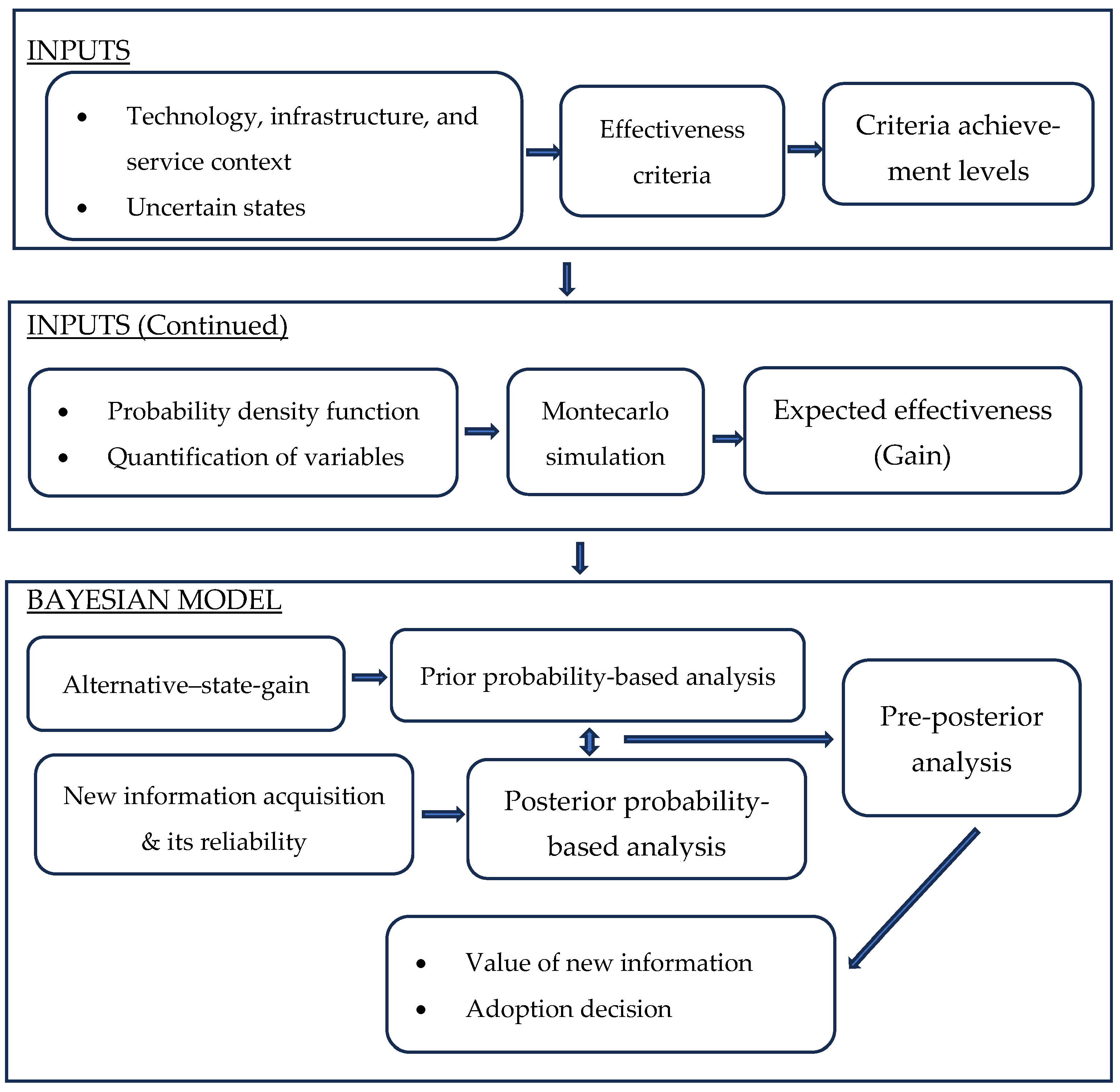
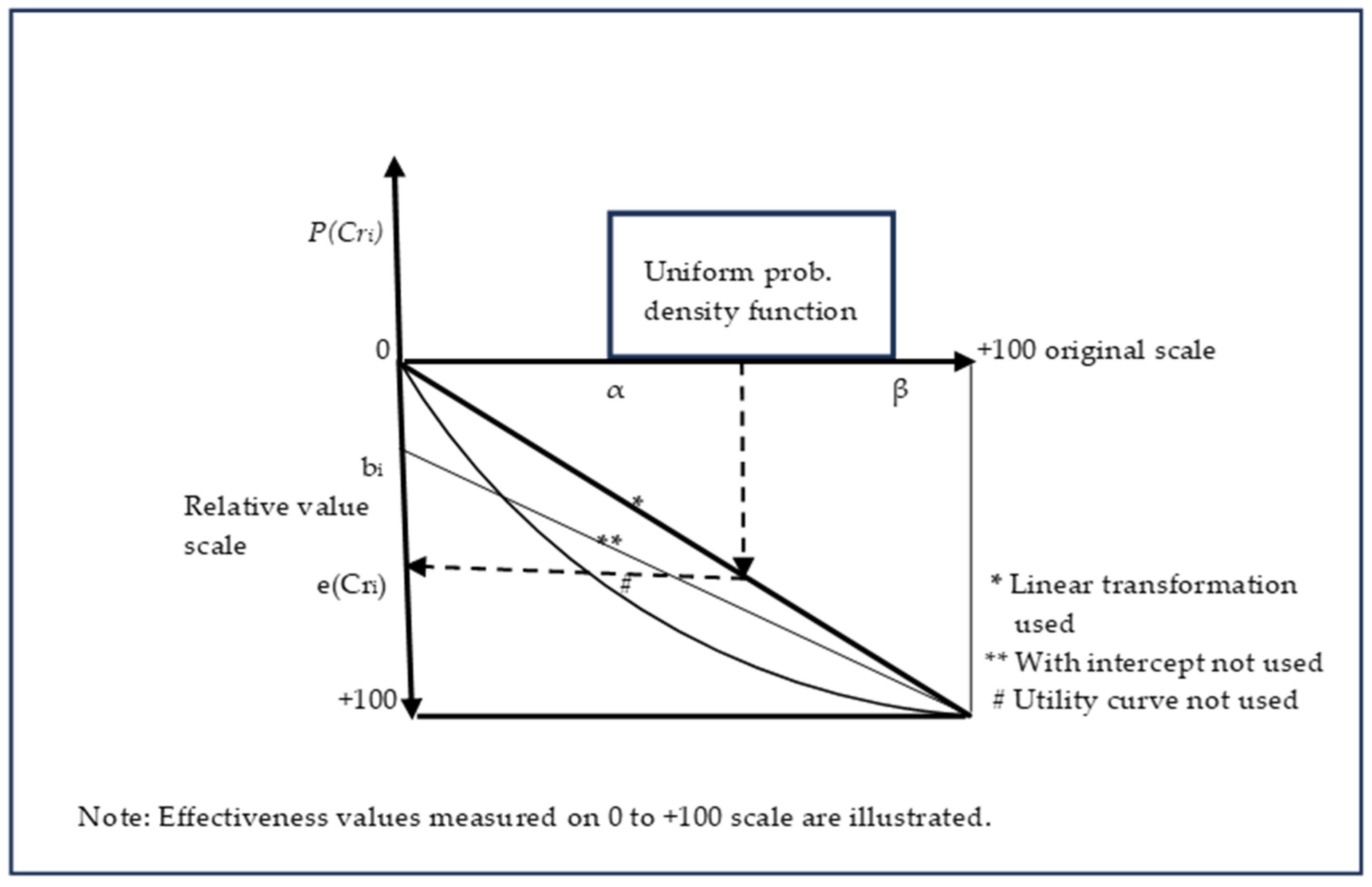
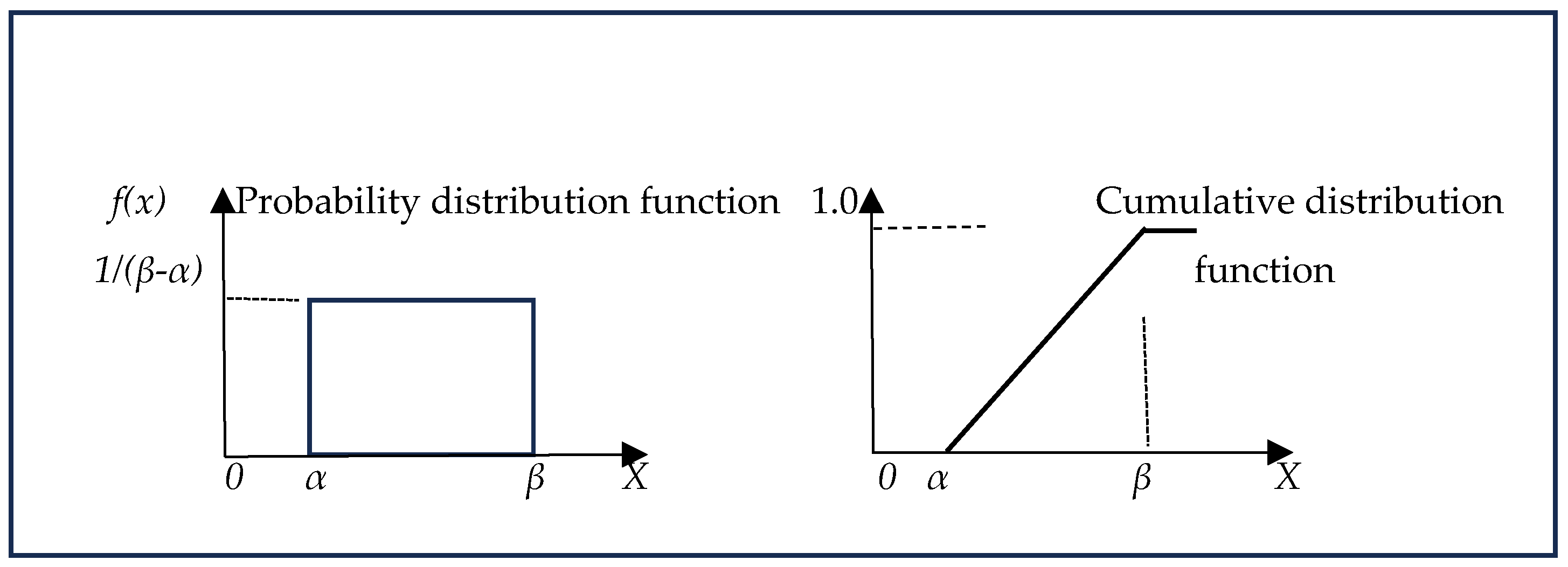


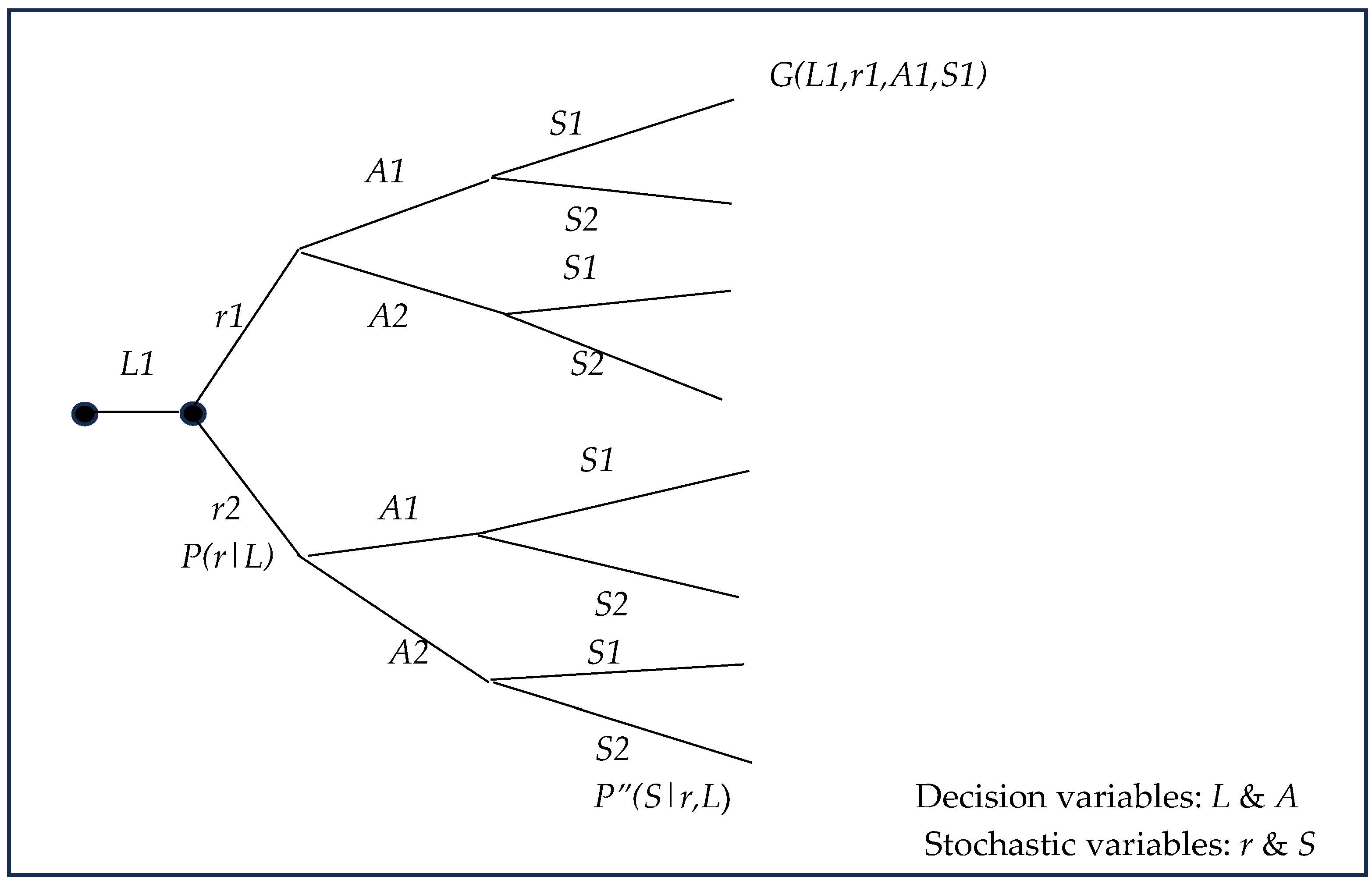

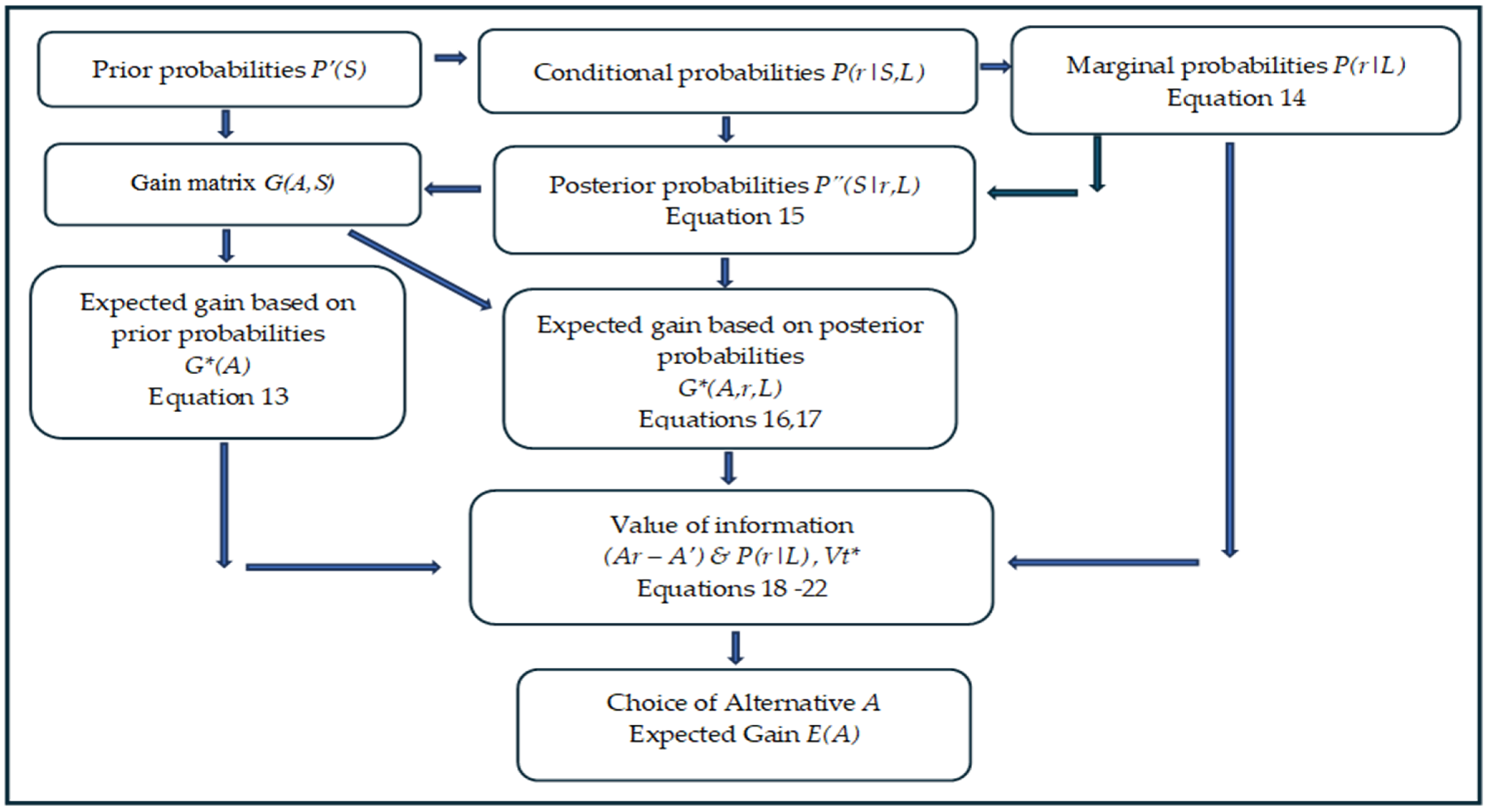
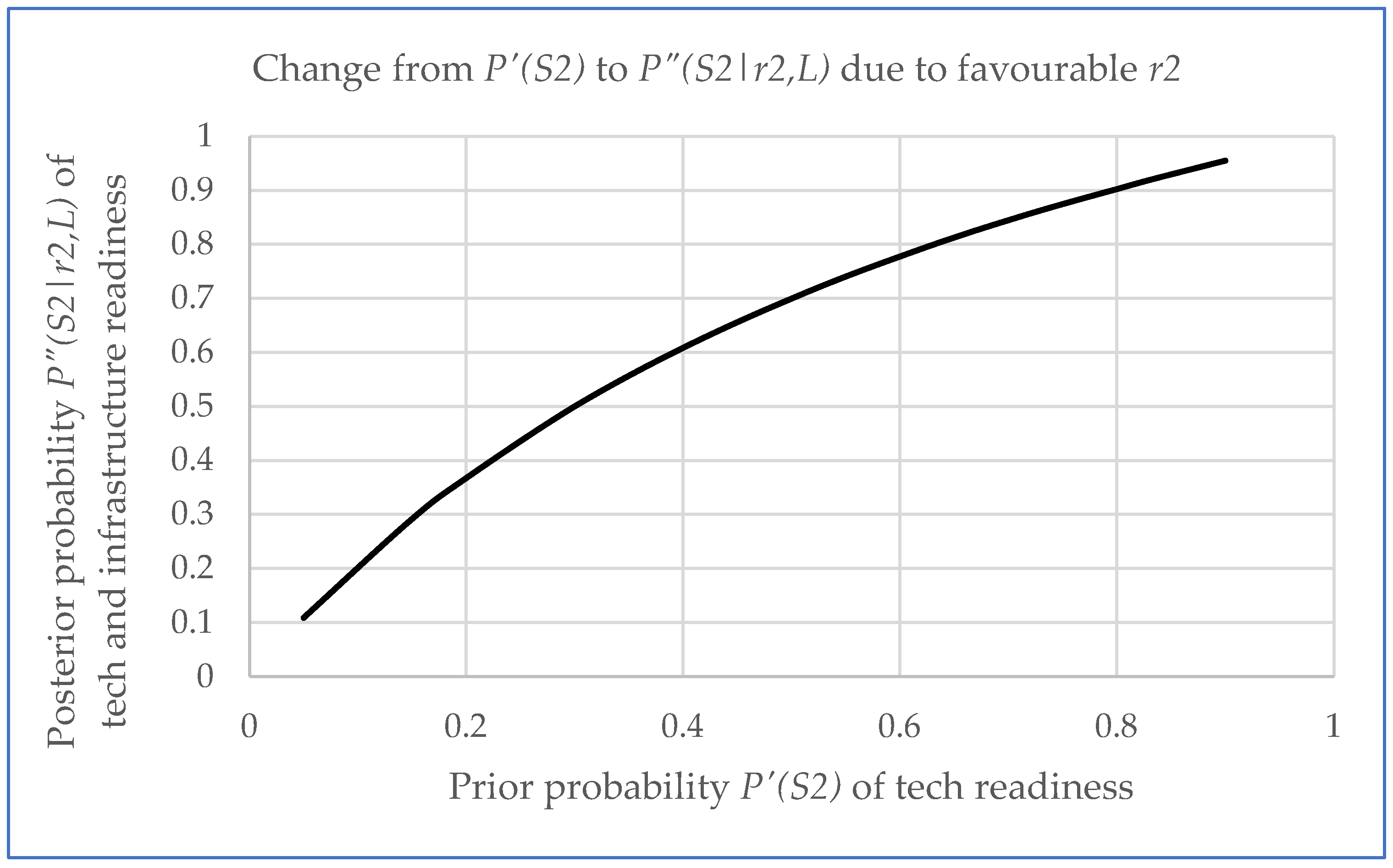
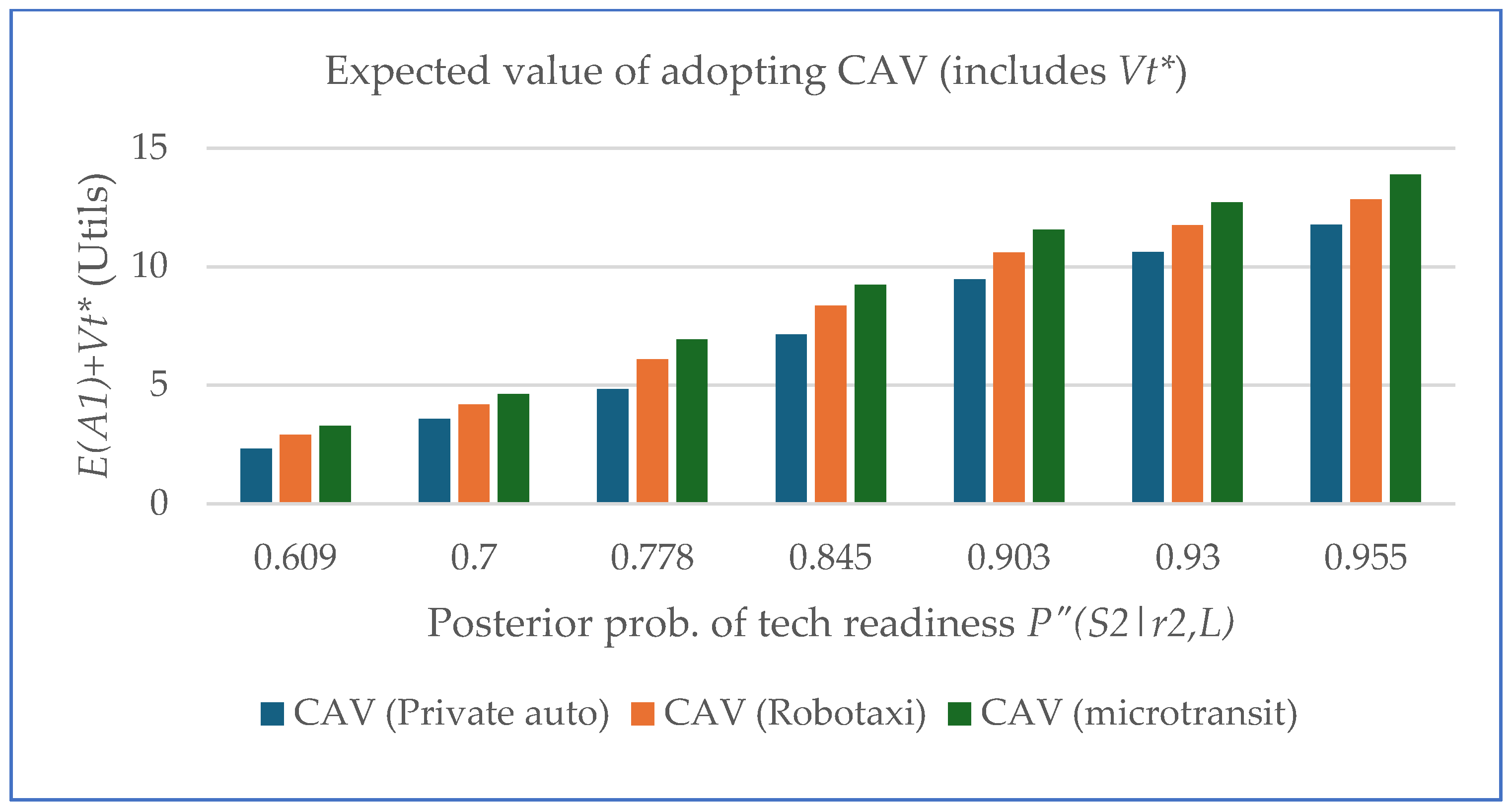
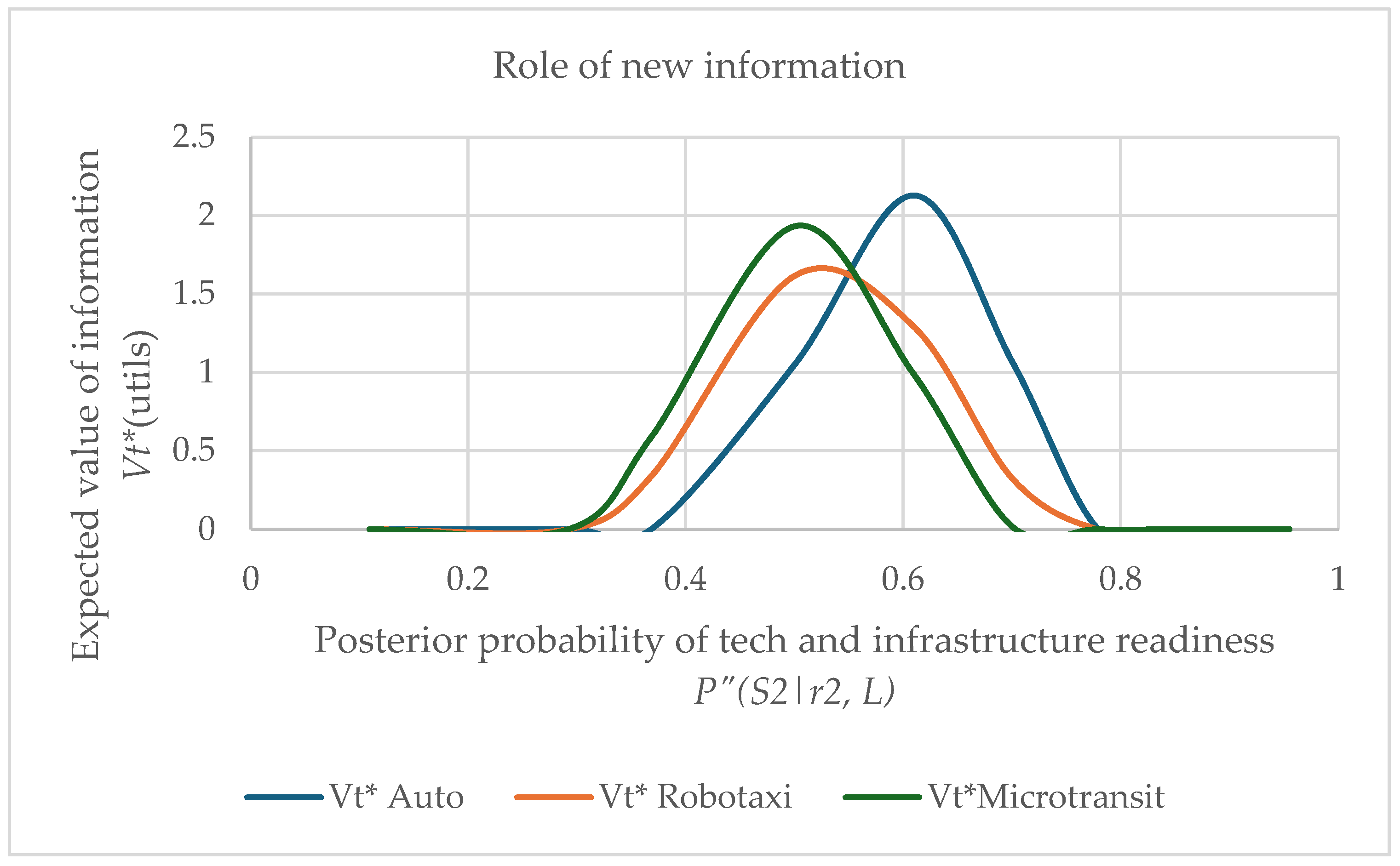
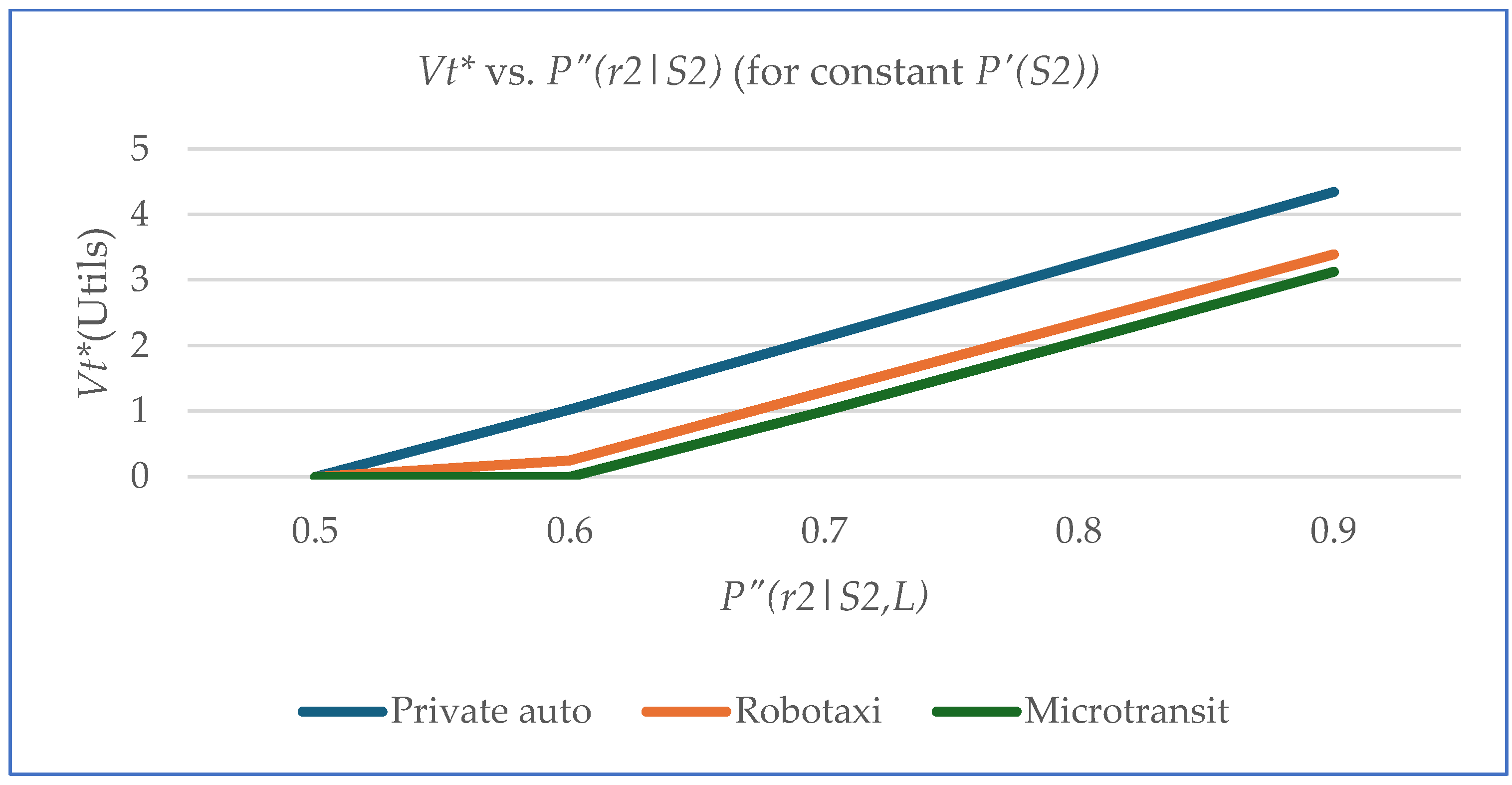
| Use Cases (2030–2035 Market Context) | Decisions | Decision-Makers | Uncertain States | Impacts (Effects) |
|---|---|---|---|---|
| Personal passenger vehicle use | A1: Purchase CAV A2: Do not purchase CAV | Individual consumer | S1: Uncertain. Low state of technology and infrastructure readiness S2: Uncertain, but higher state of technology and infrastructure readiness | Multi-attribute utility of A-S combinations. |
| Robotaxi service | A1: Invest in CAV fleet, infrastructure, operation and management system. A2: Do not. | Corporate decision | S1: Uncertain. Low state of technology and infrastructure readiness. Developing market potential. S2: Uncertain, but higher state of technology and infrastructure readiness. Promising market potential. | Multi-attribute utility of A-S combinations. |
| CAV-based microtransit Service | A1: Invest in CAV fleet, infrastructure, operation and management system. A2: Do not. | Public transit management decision. Corporate decision for private sector service. | S1: Uncertain. Low state of technology and infrastructure readiness. Developing market potential. S2: Uncertain, but higher state of technology and infrastructure readiness. Promising market potential | Multi-attribute utility of A-S combinations. |
| Criteria | Criteria Weight | Normalized Weight |
|---|---|---|
| Cr1 Human factors-related collisions avoided | 10 | 0.29 |
| Cr2 User satisfaction | 3 | 0.09 |
| Cr3 Socio-economic benefits | 2 | 0.06 |
| Cr4 Environment | 2 | 0.06 |
| Cr5 Tech unreliability | 4 | 0.12 |
| Cr6 Effect on road users | 6 | 0.18 |
| Cr7 Hacking, data security | 4 | 0.12 |
| Cr8 Cost differential | 3 | 0.09 |
| 34 | ~1.00 |
| Criteria | S1 Effectiveness (−100 to +100 Scale) | S1 Expected Effectiveness & St. Dev. Based on Triangular Probability Distribution | S1 Expected Effectiveness & St. Dev. Based on Uniform Probability Distribution | S1 Weighted Effectiveness (Based on Uniform Probability Distribution Results and Normalized Weights) |
|---|---|---|---|---|
| Cr1 Collisions avoided | 25 to 40 | 32.7 and 4.5 | 33.1 and 4.6 | 9.6 |
| Cr2 User satisfaction | 30 to 45 | 37.5 and 3.4 | 37.6 and 4.7 | 3.4 |
| Cr3 Socio-economic benefits | 15 to 30 | 22.5 and 3.4 | 22.6 and 4.2 | 1.4 |
| Cr4 Environment | 20 to 40 | 30.0 and 5.5 | 30.0 and 7.1 | 1.8 |
| Cr5 Tech unreliability | 25 to −50 | −50.5 and 6.2 | −39.2and 7.4 | −4.7 |
| Cr6 Effect on road users | −35 to −65 | −44.3 and 7.0 | −50.4 and 9.0 | −9.1 |
| Cr7 Hacking, data security | −25 to −50 | −38.3 and 5.7 | −39.2and 7.4 | −4.7 |
| Cr8 Cost differential | −60 to −90 | −76.0 and 5.4 | −75.4 and 9.2 | −6.8 −9.1 |
| Criteria | S2 Effectiveness (−100 to +100 Scale) | S2 Expected Effectiveness & St. Deviation Based on Triangular Probability Distribution | S2 Expected Effectiveness & St. Deviation Based Uniform Probability Distribution | S2 Weighted Effectiveness (Based on Uniform Probability Distribution Results and Normalized Weights) |
|---|---|---|---|---|
| Cr1 Collisions avoided | 40 to 70 | 55.1 and 6.3 | 55.2 and 9.8 | 16.0 |
| Cr2 User satisfaction | 30 to 45 | 37.8 and 3.3 | 37.8 and 4.6 | 3.4 |
| Cr3 Socio-economic benefits | 20 to 40 | 30.0 and 5.5 | 30.0 and 7.1 | 1.8 |
| Cr4 Environment | 0 to −25 | 30.0 and 5.5 | 30.0 and 7.1 | 1.8 |
| Cr5 Tech unreliability | 0 to −30 | −12.3 and 5.1 | −12.6 and 7.4 | −2.5 |
| Cr6 Effect on road users | 0 to −20 | −15.2 and 6.9 | −15.6 and 9.8 | −2.8 |
| Cr7 Hacking, data security | 0 to −20 | −10.7 and 4.6 | −10.8 and 6.9 | −1.3 |
| Cr8 Cost differential | −10 to −40 | −26.3 and 6.8 | −25.1and 8.1 | −2.3 14.1 |
| Criteria | S1 Effectiveness (−100 to +100 Scale) | S1 Expected Effectiveness & St. Deviation Based on Triangular Probability Distribution | S1 Expected Effectiveness & St. Deviation Based Uniform Probability Distribution | S1 Weighted Effectiveness (Based on Uniform Probability Distribution Results and Normalized Weights) |
|---|---|---|---|---|
| Cr1 Collisions avoided | 25 to 40 | 32.7 and 4.5 | 33.1and 4.6 | 9.6 |
| Cr2 User satisfaction | 25 to 45 | 37.5 and 4.5 | 33.3 and 4.6 | 3.0 |
| Cr3 Socio-economic benefits | 15 to 30 | 22.6 and 3.1 | 22.8 and 4.2 | 1.4 |
| Cr4 Environment | 20 to 40 | 30.0 and 5.5 | 30.0 and 7.1 | 1.8 |
| Cr5 Tech unreliability | −25 to −50 | −38.3 and 5.7 | −39.2 and 7.4 | −4.7 |
| Cr6 Effect on road users | −30 to −60 | −44.3 and 7.0 | −43.3 and 9.6 | −7.8 |
| Cr7 Hacking, data security | −25 to −50 | −38.3 and 5.7 | −39.2 and 7.4 | −4.7 |
| Cr8 Cost differential | −50 to −80 | −65.3 and 7.5 | −66.7 and 9.8 | −6.0 −7.4 |
| Criteria | S2 Effectiveness (−100 to +100 Scale) | S2 Expected Effectiveness & St. Deviation Based on Triangular Probability Distribution | S2 Expected Effectiveness & St. Deviation Based Uniform Probability Distribution | S2 Weighted Effectiveness (Based on Uniform Probability Distribution Results and Normalized Weights) |
|---|---|---|---|---|
| Cr1 Collisions avoided | 40 to 70 | 55.1 and 6.3 | 55.2 and 9.8 | 16.0 |
| Cr2 User satisfaction | 30 to 45 | 37.2 and 3.1 | 37.7 and 4.1 | 3.4 |
| Cr3 Socio-economic benefits | 20 to 40 | 30.0 and 5.5 | 30.0 and 7.1 | 1.8 |
| Cr4 Environment | 20 to 40 | 30.0 and 5.5 | 30.0 and 7.1 | 1.8 |
| Cr5 Tech unreliability | 0 to −25 | −12.2 and 5.1 | −12.7 and 7.1 | −1.5 |
| Cr6 Effect on road users | 0 to −30 | −15.2 and 6.9 | −15.6 and 9.8 | −2.8 |
| Cr7 Hacking, data security | 0 to −30 | −15.0 and 6.8 | −15.0 and 8.6 | −1.8 |
| Cr8 Cost differential | −10 to −30 | −20.9 and 4.0 | −20.4 and 5.9 | −1.8 15.1 |
| Criteria | S1 Effectiveness (−100 to +100 Scale) | S1 Expected Effectiveness & St. Dev. Based on Triangular Probability Distribution | S1 Expected Effectiveness & St. Dev. Based on Uniform Probability Distribution | S1 Weighted Effectiveness (Based on Uniform Probability Distribution Results and Normalized Weights) |
|---|---|---|---|---|
| Cr1 Collisions avoided | 25 to 40 | 32.7 and 4.5 | 33.1 and 4.6 | 9.6 |
| Cr2 User satisfaction | 25 to 40 | 32.7 and 4.5 | 33.3 and 4.6 | 3.0 |
| Cr3 Socio-economic benefits | 20 to 40 | 30.0 and 5.5 | 30.0 and 7.1 | 1.8 |
| Cr4 Environment | 20 to 40 | 30.0 and 5.5 | 30.0 and 7.1 | 1.8 |
| Cr5 Tech unreliability | −25 to −50 | −38.3 and 5.7 | −39.2 and 7.4 | −4.7 |
| Cr6 Effect on road users | −30 to −60 | −44.3 and 7.0 | −43.3 and 9.6 | −7.8 |
| Cr7 Hacking, data security | −25 to −50 | −38.3 and 5.7 | −39.2 and 7.4 | −4.7 |
| Cr8 Cost differential | −50 to −80 | −65.3 and 7.5 | −66.7 and 9.8 | −6.0 −7.0 |
| Criteria | S2 Effectiveness (−100 to +100 Scale) | S2 Expected Effectiveness & St. Deviation Based on Triangular Probability Distribution | S2 Expected Effectiveness & St. Deviation Based Uniform Probability Distribution | S2 Weighted Effectiveness (Based on Uniform Probability Distribution Results and Normalized Weights) |
|---|---|---|---|---|
| Cr1 Collisions avoided | 40 to 70 | 55.1 and 6.3 | 55.2 and 9.8 | 16.0 |
| Cr2 User satisfaction | 25 to 40 | 32.7 and 4.5 | 33.3 and 4.6 | 3.0 |
| Cr3 Socio-economic benefits | 20 to 40 | 30.0 and 5.5 | 30.0 and 7.1 | 1.8 |
| Cr4 Environment | 20 to 40 | 30.0 and 5.5 | 30.0 and 7.1 | 1.8 |
| Cr5 Tech unreliability | 0 to −17.5 | −8.6 and 4.5 | −8.3 and 6.4 | −1.0 |
| Cr6 Effect on road users | 0 to −30 | −15.2 and 6.9 | −15.6 and 9.8 | −2.8 |
| Cr7 Hacking, data security | 0 to −20 | −10.7 and 4.6 | −10.8 and 6.9 | −1.3 |
| Cr8 Cost differential | 0 to −30 | −14.9 and 5.8 | −14.4 and 9.4 | −1.3 16.2 |
| Variables and Processes (1) | Effectiveness Criteria and Weights (2) | Effectiveness Criteria Values (Ranges) (Utils) (3) | Montecarlo Method (Triangular Prob. Distribution) (Utils) (4) | Monte Carlo Method (Uniform Prob. Distribution) (Utils) (5) | Weighted Expected Effectiveness (Utils) (2) × (5) |
|---|---|---|---|---|---|
| Processes and results. | Cr1 to Cr8. Raw and normalized weights. | Effectiveness ranges defined. | Computation of probability-weighted effectiveness. | Computation of probability-weighted effectiveness. | Multiplication of (2) × (5) Sum of utils. |
| Location of results in Table 2, Table 3, Table 4, Table 5, Table 6, Table 7 and Table 8. | Table 2 | Table 3, Table 4, Table 5, Table 6, Table 7 and Table 8 column 2 | Table 3, Table 4, Table 5, Table 6, Table 7 and Table 8 column 3 | Table 3, Table 4, Table 5, Table 6, Table 7 and Table 8 column 4 | Table 3, Table 4, Table 5, Table 6, Table 7 and Table 8 column 5 |
| Prior Prob. P′(S1) and P′(S2) | Conditional Prob. P(r1|S1) and P(r2|S1) | Selected Conditional Prob. P(r1|S2) and P(r2|S2) | Selected Posterior Prob. P″(S1|r2,L) and P″(S2|r2,L) | Gain (Utils) G(A1,S1) and G(A2,S1) | Gain (Utils) G(A1,S2) and G(A2,S2) | Value of New Information Vt*(Utils) | Choice of A and E(A) (Utils) | Interpretation of Results |
|---|---|---|---|---|---|---|---|---|
| 0.95 and 0.05 to 0.80 and 0.20 | 0.7 and 0.30 | 0.3 and 0.70 | 0.891 and 0.109 To 0.632 and 0.368 | −9.1 and 0 | 14.1 and 0 | 0 | A2 and 0 | CAV will not be adopted. New information will not change the choice. |
| 0.70 and 0.30 | 0.7 and 0.30 | 0.3 and 0.70 | 0.500 and 0.500 | −9.1 and 0 | 14.1 and 0 | 1.05 | A2 and 0 | CAV will not be adopted. But new information can reduce risk. |
| 0.60 and 0.40 | 0.7 and 0.30 | 0.3 and 0.70 | 0.391 and 0.609 | −9.1 and 0 | 14.1 and 0 | 2.13 | A1 and 0.18 | CAV will be adopted, subject to new information for risk reduction. |
| 0.50 and 0.50 | 0.7 and 0.30 | 0.3 and 0.70 | 0.300 and 0.700 | −9.1 and 0 | 14.1 and 0 | 1.07 | A1 and 2.50 | CAV will be adopted, subject to new information for risk reduction. |
| 0.40 and 0.60 | 0.7 and 0.30 | 0.3 and 0.70 | 0.222 and 0.778 | −9.1 and 0 | 14.1 and 0 | 0.01 | A1 and 4.82 | CAV will be adopted, subject to new information for risk reduction. |
| 0.30 and 0.70 | 0.7 and 0.30 | 0.3 and 0.70 | 0.155 and 0.845 | −9.1 and 0 | 14.1 and 0 | 0 | A1 and 7.14 | CAV will be adopted. No need for new information. |
| 0.20 and 0.80 | 0.7 and 0.30 | 0.3 and 0.70 | 0.097 and 0.903 | −9.1 and 0 | 14.1 and 0 | 0 | A1 and 9.46 | CAV will be adopted. No need for new information. |
| 0.15 and 0.85 | 0.7 and 0.30 | 0.3 and 0.70 | 0.070 and 0.930 | −9.1 and 0 | 14.1 and 0 | 0 | A1 and 10.62 | CAV will be adopted. No need for new information. |
| 0.10 and 0.90 | 0.7 and 0.30 | 0.3 and 0.70 | 0.045 and 0.955 | -.9.1 and 0 | 14.1 and 0 | 0 | A1 and 11.78 | CAV will be adopted. No need for new information. |
| Prior Prob. P’(S1) and P’(S2) | Conditional Prob. P(r1|S1) and P(r2|S1) | Selected Conditional Prob. P(r1|S2) and P(r2|S2) | Selected Posterior Prob. P″(S1|r2,L) and P″(S2|r2,L) | Gain (Utils) G(A1,S1) and G(A2,S1) | Gain (Utils) G(A1,S2) and G(A2,S2) | Value of New Information Vt*(Utils) | Choice of A and E(A) (Utils) | Interpretation of Results |
|---|---|---|---|---|---|---|---|---|
| 0.95 and 0.05 to 0.85 and 0.15 | 0.7 and 0.30 | 0.3 and 0.70 | 0.891 and 0.109 to 0.708 and 0.292 | −7.4 and 0 | 15.1 and 0 | 0 to 0 | A2 and 0 | CAV will not be adopted. New information will not change the choice. |
| 0.80 and 0.20 | 0.70 and 0.30 | 0.3 and 0.70 | 0.632 and 0.368 | −7.4 and 0 | 15.1 and 0 | 0.338 | A2 and 0 | CAV will not be adopted. But new information can reduce risk. |
| 0.70 and 0.30 | 0.7 and 0.30 | 0.3 and 0.70 | 0.500 and 0.500 | −7.4 and 0 | 15.1 and 0 | 1.617 | A2 and 0 | CAV will not be adopted. But new information can reduce risk. |
| 0.60 and 0.40 | 0.7 and 0.30 | 0.3 and 0.70 | 0.391 and 0.609 | −7.4 and 0 | 15.1 and 0 | 1.296 | A1 and 2.896 | CAV will be adopted, subject to new information for risk reduction. |
| 0.50 and 0.50 | 0.7 and 0.30 | 0.3 and 0.70 | 0.300 and 0.700 | −7.4 and 0 | 15.1 and 0 | 0.325 | A1 and 3.85 | CAV will be adopted, subject to new information for risk reduction. |
| 0.40 and 0.60 | 0.7 and 0.30 | 0.3 and 0.70 | 0.222 and 0.778 | −7.4 and 0 | 15.1 and 0 | 0 | A1 and 6.1 | CAV will be adopted. No need for new information. |
| 0.30 and 0.70 | 0.7 and 0.30 | 0.3 and 0.70 | 0.155 and 0.845 | −7.4 and 0 | 15.1 and 0 | 0 | A1 and 8.35 | CAV will be adopted. No need for new information. |
| 0.20 and 0.80 | 0.7 and 0.30 | 0.3 and 0.70 | 0.097 and 0.903 | −7.4 and 0 | 15.1 and 0 | 0 | A1 and 10.6 | CAV will be adopted. No need for new information. |
| 0.15 and 0.85 | 0.7 and 0.30 | 0.3 and 0.70 | 0.070 and 0.930 | −7.4 and 0 | 15.1 and 0 | 0 | A1 and 11.725 | CAV will be adopted. No need for new information. |
| 0.10 and 0.90 | 0.7 and 0.30 | 0.3 and 0.70 | 0.045 and 0.955 | −7.4 and 0 | 15.1 and 0 | 0 | A1 and 12.85 | CAV will be adopted. No need for new information. |
| Prior Prob. P’(S1) and P’(S2) | Conditional Prob. P(r1|S1) and P(r2|S1) | Conditional Prob. P(r1|S2) and P(r2|S2) | Selected Posterior Prob. P”(S1|r2,L) and P”(S2|r2,L) | Gain (Utils) G(A1,S1) and G(A2,S1) | Gain (Utils) G(A1,S2) and G(A2,S2) | Value of New Information Vt*(Utils) | Choice of A and E(A) (Utils) | Interpretation of Results |
|---|---|---|---|---|---|---|---|---|
| 0.95 and 0.05 to 0.85 and 0.15 | 0.7 and 0.30 | 0.3 and 0.70 | 0.891 and 0.109 to 0.708 and 0.292 | −7.0 and 0 | 16.2 and 0 | 0 to 0 | A2 and 0 | CAV will not be adopted. New information will not change the choice. |
| 0.80 and 0.20 | 0.70 and 0.30 | 0.3 and 0.70 | 0.632 and 0.368 | −7.0 and 0 | 16.2 and 0 | 0.588 | A2 and 0 | CAV will not be adopted. But new information can reduce risk. |
| 0.70 and 0.30 | 0.7 and 0.30 | 0.3 and 0.70 | 0.500 and 0.500 | −7.0 and 0 | 16.2 and 0 | 1.932 | A2 and 0 | CAV will not be adopted. But new information can reduce risk. |
| 0.60 and 0.40 | 0.7 and 0.30 | 0.3 and 0.70 | 0.391 and 0.609 | −7.0 and 0 | 16.2 and 0 | 0.996 | A1 and 2.28 | CAV will be adopted, subject to new information for risk reduction. |
| 0.50 and 0.50 | 0.7 and 0.30 | 0.3 and 0.70 | 0.300 and 0.700 | −7.0 and 0 | 16.2 and 0 | 0.02 | A1 and 4.60 | CAV will be adopted, subject to new information for risk reduction. |
| 0.40 and 0.60 | 0.7 and 0.30 | 0.3 and 0.70 | 0.222 and 0.778 | −7.0 and 0 | 16.2 and 0 | 0 | A1 and 6.92 | CAV will be adopted. No need for new information. |
| 0.30 and 0.70 | 0.7 and 0.30 | 0.3 and 0.70 | 0.155 and 0.845 | −7.0 and 0 | 16.2 and 0 | 0 | A1 and 9.24 | CAV will be adopted. No need for new information. |
| 0.20 and 0.80 | 0.7 and 0.30 | 0.3 and 0.70 | 0.097 and 0.903 | −7.0 and 0 | 16.2 and 0 | 0 | A1 and 11.56 | CAV will be adopted. No need for new information. |
| 0.15 and 0.85 | 0.7 and 0.30 | 0.3 and 0.70 | 0.070 and 0.930 | −7.0 and 0 | 16.2 and 0 | 0 | A1 and 12.72 | CAV will be adopted. No need for new information. |
| 0.10 and 0.90 | 0.7 and 0.30 | 0.3 and 0.70 | 0.045 and 0.955 | −7.0 and 0 | 16.2 and 0 | 0 | A1 and 13.88 | CAV will be adopted. No need for new information. |
| P(r2|S2,L) | P′(S1) and P′(S2) | P″(S2|r2,L) | Private Auto Vt* | Robotaxi Vt* | Microtransit Vt* |
|---|---|---|---|---|---|
| 0.5 | 0.6 and 0.4 | 0.40 | 0 | 0 | 0 |
| 0.6 | 0.6 and 0.4 | 0.50 | 1.02 | 0.248 | 0 |
| 0.7 | 0.6 and 0.4 | 0.609 | 2.13 | 1.296 | 1 |
| 0.8 | 0.6 and 0.4 | 0.727 | 3.24 | 2.344 | 2.06 |
| 0.9 | 0.6 and 0.4 | 0.857 | 4.35 | 3.392 | 3.13 |
Disclaimer/Publisher’s Note: The statements, opinions and data contained in all publications are solely those of the individual author(s) and contributor(s) and not of MDPI and/or the editor(s). MDPI and/or the editor(s) disclaim responsibility for any injury to people or property resulting from any ideas, methods, instructions or products referred to in the content. |
© 2025 by the author. Licensee MDPI, Basel, Switzerland. This article is an open access article distributed under the terms and conditions of the Creative Commons Attribution (CC BY) license (https://creativecommons.org/licenses/by/4.0/).
Share and Cite
Khan, A.M. Bayesian Predictive Model for Electric Level 4 Connected Automated Vehicle Adoption. Future Transp. 2025, 5, 108. https://doi.org/10.3390/futuretransp5030108
Khan AM. Bayesian Predictive Model for Electric Level 4 Connected Automated Vehicle Adoption. Future Transportation. 2025; 5(3):108. https://doi.org/10.3390/futuretransp5030108
Chicago/Turabian StyleKhan, Ata M. 2025. "Bayesian Predictive Model for Electric Level 4 Connected Automated Vehicle Adoption" Future Transportation 5, no. 3: 108. https://doi.org/10.3390/futuretransp5030108
APA StyleKhan, A. M. (2025). Bayesian Predictive Model for Electric Level 4 Connected Automated Vehicle Adoption. Future Transportation, 5(3), 108. https://doi.org/10.3390/futuretransp5030108





